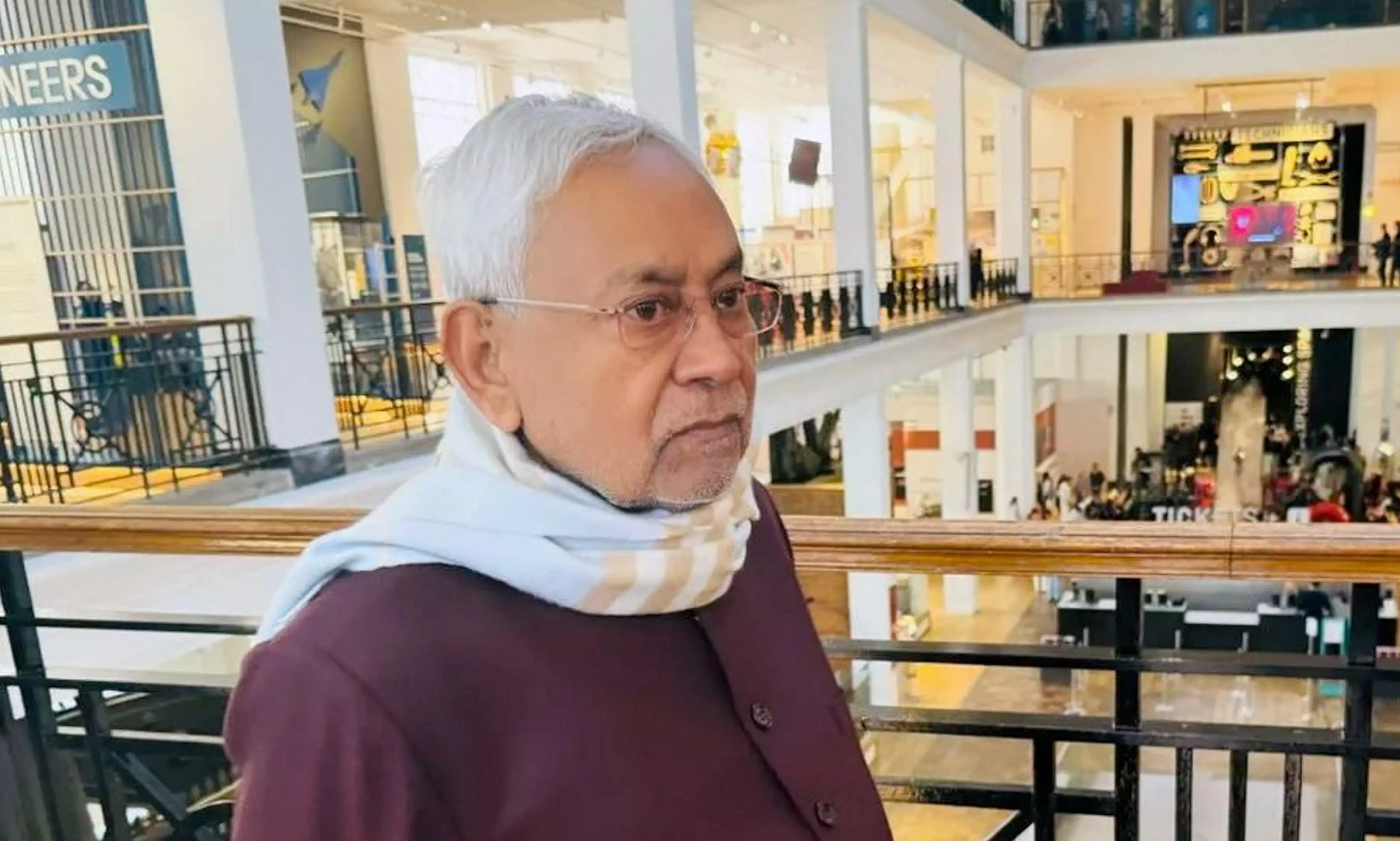
- Home
- India
- World
- Premium
- THE FEDERAL SPECIAL
- Analysis
- States
- Perspective
- Videos
- Sports
- Education
- Entertainment
- Elections
- Features
- Health
- Business
- Series
- In memoriam: Sheikh Mujibur Rahman
- Bishnoi's Men
- NEET TANGLE
- Economy Series
- Earth Day
- Kashmir’s Frozen Turbulence
- India@75
- The legend of Ramjanmabhoomi
- Liberalisation@30
- How to tame a dragon
- Celebrating biodiversity
- Farm Matters
- 50 days of solitude
- Bringing Migrants Home
- Budget 2020
- Jharkhand Votes
- The Federal Investigates
- The Federal Impact
- Vanishing Sand
- Gandhi @ 150
- Andhra Today
- Field report
- Operation Gulmarg
- Pandemic @1 Mn in India
- The Federal Year-End
- The Zero Year
- Science
- Brand studio
- Newsletter
- Elections 2024
- Events
- Home
- IndiaIndia
- World
- Analysis
- StatesStates
- PerspectivePerspective
- VideosVideos
- Sports
- Education
- Entertainment
- ElectionsElections
- Features
- Health
- BusinessBusiness
- Premium
- Loading...
Premium - Events

The Bihar CM’s predicament stems from his quest to be pragmatic and strike profitable bargains while wanting to project himself as an idealist leader
In an uncharacteristic move, Bihar Chief Minister Nitish Kumar on March 6 went on a week-long “vacation” to the United Kingdom, in the course of which he would travel to Scotland to seek foreign investments in the state and also visit a “science museum”.
It was equally perplexing that before proceeding to Delhi, he skipped an official rally in West Champaran district on the same day even though it was addressed by none other than Prime Minister Narendra Modi.
Although the Prime Minister harped on the benefits of a “double-engine” government and spared no effort in talking highly of the state government and the Chief Minister, raising eyebrows would be justified because the second propellant of the state regime was missing barely days after making up with the BJP.
Nitish Kumar’s absence was more conspicuous because Modi announced and initiated schemes and projects valued at Rs 12,800 crore. These events have become typical of the Modi regime in the run-up to the elections.
Aurangabad embarrassment
Nitish Kumar’s absence at the events in Bettiah was all the more conspicuous because he previously shared the stage with Modi on March 2 in Aurangabad, where too projects valued at Rs 21,400 crore were unveiled. In that programme, the Bihar CM was caught on the wrong foot when Modi virtually pulled him inside a giant-sized garland that local BJP leaders presented to the Prime Minister.
The Aurangabad public rally was the first occasion that the Bihar CM appeared on a public platform with the PM after his return to the National Democratic Alliance (NDA) fold in January. But Modi’s impromptu act, of virtually pulling Nitish Kumar inside the garland, clearly made the latter very uncomfortable given the past awkwardness in their personal and political relationship.
With the CM now absenting himself from Modi’s event in West Champaran, it will be worth tracking if this becomes the trend during the electoral campaign — Modi and Nitish Kumar campaigning separately and not appearing on a common platform.
Nitish's unease
In the event of this becoming a regular feature during the impending Lok Sabha elections, it would certainly dent the prospects of the NDA’s candidates. The fact that the Bihar CM will combine meetings with BJP leaders in New Delhi with his vacation to discuss seat sharing indicates that several issues between the newly-reunited allies remains to be sorted out.
In recent days, the process of seat sharing has become increasingly complicated as the BJP grapples with more allies than what can be accommodated while also trying to ensure that none of its own seats have to be forsaken.
Nitish Kumar’s unease regarding sharing public platforms with Modi stems from his inability to accept his role as the second fiddle in the alliance. In a larger perspective, the CM’s predicament stems from his quest to be pragmatic and strike the most profitable bargains while wanting to project himself as an idealist leader rooted in socialist or egalitarian politics.
Part of this is related to Nitish Kumar’s political genesis and the long history of simultaneously striking alliances with the BJP and its political predecessor, the Bharatiya Jana Sangh, while being critical of the Sangh Parivar’s ideology. This dilemma stems from his hope of restoring support for himself and his party, Janata Dal (United), among the Muslims while retaining support among non-dominant groups among OBCs.
Changing equations
In recent years, this strategy has come undone, with diminishing electoral returns, especially after June 2013, when Nitish Kumar parted ways with the BJP in protest against the emergence of Modi as the party’s electoral mascot and eventually the prime ministerial candidate.
As a result of multiple reasons and the JD(U)’s political inconsistencies, the BJP has emerged as the senior partner while the JD(U) has been downsized numerically and has also lost its pre-eminence that earlier enabled it to be the deciding authority on seat sharing, projects, and policies.
The Bihar CM has to now deal with the BJP’s central leadership and not the state leaders, which was permitted in the pre-Modi era when the traditional collegial style of functioning prevailed within the BJP. This development has been accompanied by an exponential increase in the value of Modi’s political stock.
This is, as demonstrated in Nitish Kumar’s absence from the public event in West Champaran, clearly not to his liking, but there is little he can do. In Aurangabad, too, it was palpable that Modi’s melodramatic cuddle of the CM was disapproved by him but he was powerless to rebuff the public embrace.
Nitish’s dream
A major factor behind the CM treating the alliance with the BJP more as a burden but something he cannot abandon emerges from his initial hope — formed during the BJP’s transitional years from 2004 onwards — that he would be projected as the NDA’s PM candidate, just as the BJP projected him for the Bihar chief ministership from the late 1990s even though the Samata Party was the secondary force in the alliance.
It is worth recalling that when the NDA made the first bid to form the government in Bihar, in March 2000, Nitish Kumar was made the CM because the BJP did not have any tall leader for the office. Even now, the BJP faces that deficit, forcing it to smoke the peace pipe with Nitish Kumar.
In March 2000, that attempt to take control of the state came to a naught in a week, but Nitish Kumar remained the alliance’s candidate in 2005 when the alliance secured legislative majority. Thereafter, he assumed that he would continue to be the NDA’s PM face because the BJP was in the process of evaluating options for a new generation of parliamentary leaders.
With the second-rung leaders engaged in mutual tussle, Nitish Kumar assumed he stood a good chance. With Modi emerging as an important challenger, Nitish Kumar tried to undermine the then Gujarat CM’s image by disallowing him from campaigning in Bihar.
Open hostilities
Hostilities between the two was visible on the occasions when they crossed paths for meetings of CMs that are regularly convened by the Centre and its agencies. Nitish Kumar also demanded from the BJP that Bihar must remain off limits for Modi, who actually never visited the state for long, starting 2005, from when he was disallowed to campaign in the Assembly polls.
During the 2009 parliamentary polls, the two warring CMs perforce had to share a common platform for an election rally in Ludhiana, Punjab. Modi apparently got to know of this in advance and planned his strategy whereas Nitish Kumar remained unaware till almost the end.
When the two finally came face to face, Modi walked up to Nitish and, before the latter could realise what the Gujarat strongman was doing, clasped his hand and held it aloft for the bevy of photographers to click pictures and dispatch it to news centres. The picture of the two became a big talking point, much to the Bihar CM’s annoyance, but he could do little to prevent its spread.
An angry Nitish
Nitish Kumar was very angry with Modi but could do little to prevent his supporters from believing that the two leaders had buried the hatchet.
He got his chance next year, in June 2010, when the BJP held its National Executive meeting in Patna. But on this occasion, too, it was Modi who once again riled Nitish Kumar first, by inserting an advertisement of Gujarat offering Bihar money for flood relief.
The announcement was made with a full-page advertisement of the 2009 picture of the two chief ministers holding hands aloft. The advertisement was published in several Patna newspapers.
Nitish Kumar described the act as “unethical and uncultured”. He also said that the manner in which his Gujarat counterpart had been advocating his “model of development” and recommending it for emulation in Bihar was highly objectionable. Taking hostilities to a new level, the CM cancelled an official dinner for which he invited the BJP’s delegates, at the eleventh hour.
Nitish’s taunts
In September next year, when Modi embarked on his Sadbhavna (social harmony) programme, to mount his intra-party campaign for the BJP’s leadership, he turned down the offer of a skull cap from a Muslim clergyman.
Although this consolidated support for Modi among his core Hindu supporters, it nonetheless revived the narrative of depicting Modi as a Hindu majoritarian leader. At that time, Nitish Kumar famously mocked Modi: “Modi Ji, this is Hindustan. Sometimes you have to don the tilak (vermillion mark on forehead) and at other times you have to accept the topi (cap).”
Predictably, Modi fumed at this affront and few were surprised when the JD(U) walked out of the NDA in 2013.
Nitish Kumar’s taunts were duplicitous because he remained the railways minister in the BJP-led NDA government even after the 2002 Gujarat riots. He also disregarded the fact that some of his Cabinet colleagues declared that they were active RSS members and asserted that they had participated in kar seva in Ayodhya.
The Bihar CM also attended the BJP’s annual meeting in Mumbai in 1995 when Atal Bihari Vajpayee was handed back the party’s leadership by Lal Krishna Advani after the Hawala scam surfaced.
How long will it last?
Despite Nitish Kumar’s shifting loyalties, Modi has forged an alliance with the JD(U) whenever it has sought to tie up. But from 2017 onwards, the terms of the pact have not been set by him. The present relationship is certainly not a permanent one and there are questions, given the discomfort for one another, if it would survive much beyond 2024 for the next Assembly polls due in October-November 2025.
Because of the past occasions when Nitish Kumar has riled Modi, and given his hegemonic presence, it can be assumed that Modi will eventually be Nitish Kumar’s nemesis.
The Bihar CM probably knows this too, but can do little to counter it because of his diminishing electoral and organisational clout. His effort is now mainly focussed on remaining in harness till he runs out of options.
Until the time and occasions permit, Nitish Kumar is capable of changing loyalties again despite pledging to Modi in Aurangabad that he will not go “astray” and venture off to other pastures.
(The Federal seeks to present views and opinions from all sides of the spectrum. The information, ideas or opinions in the articles are of the author and do not necessarily reflect the views of The Federal.)


